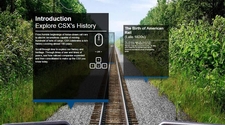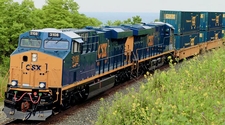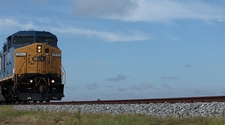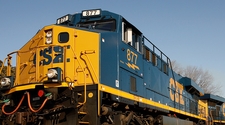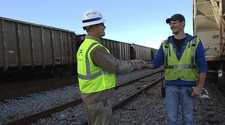| A End of Car
|
The opposite end from which the hand brake is mounted. The term is commonly used with 'L' or 'R' to designate left or right side. Used to specify placement, report damage, etc. |
| A Unit (AKA Lead Unit) |
A locomotive unit equipped with a cab and operating controls. |
| A/C Locomotive |
The newest type of locomotive in the CSX fleet. The A/C locomotive operates using alternating current and can move more tonnage faster. |
| AAR - Association of American Railroads |
The central coordinating and research agency of the North American rail industry. It deals with matters of common concern to member roads; operations, hardware standardization, regulatory matters research, safety, forecasts, finance, etc. It is dedicated to the standardization of processes and progress of the rail transportation industry. |
| Abandonment |
Refusal to receive freight, so damaged in transit as to be worthless, and render carrier liable for its value. |
| Absolute Block |
A block that may be occupied by only one train at a time. |
| Absolute Signal |
A color light, color position light, or semaphore signal without a number plate, "P" marker, "APP" marker, "C" marker, or "G" marker that conveys stop as its most restrictive indication. |
| Absorption |
The assumption of switching or other charges of one carrier by another carrier without increasing the rate to the shipper or receiver of freight. |
| Abstract |
Accounting form used for division of revenue. |
| Abstract of Charges |
A recap of the freight bills issued by a station. Used for accumulating information into daily and monthly totals for general records. |
| Abstract of Waybills |
A report of freight received and dispatched from a station. This information is taken from waybills for shipments and/or forwarded to other properties or stations. |
| Abutment
|
A mass of masonry supporting an arch or beam at the ends of a bridge.
|
| Acceptance |
Receipt by the consignee of a shipment, thus terminating the common carrier liability. |
| Accessorial Charges |
Incidental charges for service rendered such as demurrage, weighing, diversions, etc. which are in addition to normal transportation charges. |
| Accessorial Service |
A service, such as heating, cooling, stop-off, diversion, etc., rendered by a carrier in addition to a transportation service. |
| Account Code 101L (Outbound) |
The account code used on the waybill to designate the amount to be allowed the junction settlement carriers on shipments originating on their railroads (Outbound). Amounts applied to this account code are always placed in the advances column of the waybill and in the prepaid column when applicable. Amounts applied to account code 101L must never be placed in the freight column of the waybill. |
| Account Code 101M (Inbound) |
The account code used on the waybill to designate the amount to be allowed the junction settlement carriers on shipments terminating on their railroads (Inbound). Amounts applied to this account code are always placed in the freight column of the waybill and in the prepaid column when applicable. Amounts applied to Account Code 101M must never be placed in the advances column of the waybill. |
| Act of God |
An act occasioned by violence of nature which no reasonable human foresight, care, or diligence can anticipate or prevent. |
| Actual Placement |
Physically placing a car for loading or unloading at a place designated by, or usually used by, the shipper or consignee. |
| Adjustment (Accounts Receivable) |
The transfer of monies from one account to another (i.e., transferring the responsibility of an open item from Accounts Receivable to Overcharge Claims through a 743-P adjustment). |
| Adoption Notice |
A notice required to be filed with the STB by a carrier or person taking over operating control of another carrier, or assuming control of part of another carrier's line. |
| Advance Billing |
A transfer of charges due to an error in billing a shipment. Example: Shipment originally billed "collect" in error - should have been prepaid. Agent at origin requests charges be advanced back to shipper. |
| Advance Charges |
Charges stated in advances column of waybill accruing to waybilling carrier for services rendered, to be collected from shipper or consignee. Services such as Reconsignment, Diversion, and Stop-off to complete unloading or partial unloading are examples of accessorial charges in advance column of waybill. |
| Advance Consist |
A listing of all rail cars on a train, in train order, that is transmitted from station to station in advance of the train's arrival. |
| Advance Notice |
A notification of an approaching event or intended action, such as notice to a customer that cars ordered will soon be placed at their industry. |
| Advance of a Signal |
Passed the signal. |
| Advances Only |
Charges for services performed other than the actual movement of freight. |
| Advise Shipment |
Shipment consigned to one party, to be delivered only upon surrender of a written order. Such shipments must move on straight bills of lading. |
| Adze
|
An axe-like tool used to shave or smooth the top of wood ties. |
| Adzing Machine
|
Portable, power-operated machine designed to adze the rail seat on ties to provide an even bearing surface for tie plates. |
| AEI |
See Automatic Equipment Identification. |
| Affidavit |
A written statement sworn to before a notary public. |
| After-The-Fact Refund |
A reduction in revenue because an incentive was given to encourage shipping. |
| Age |
Term of time in service, usually referring to seniority. |
| Agency |
A designated location for conducting railroad business or a local railroad customer service office. |
| Agency Pools |
Equipment pools where cars are assigned to a local agent and are returned empty to that agent when unloaded at the ultimate destination. |
| Agency Tariff |
A tariff issued by a publishing agent for one or more carriers. |
| Agent
|
Short for Freight Agent. A person, association or corporation authorized to publish and file rates and provisions for a carrier's account in tariffs published in the agent's name.
|
| Aggregate Rate (AKA Combination Rate) |
A rate made by combining two or more rates, one of which terminates and the other originates at a common point short of the ultimate destination. A combination rate is applied under the rules and conditions of an aggregate of intermediates clause in the tariff containing the otherwise applicable through rate. |
| Aggregate-of-Intermediate Clause |
The provision in Section 4, Part I, of the Interstate Commerce Act which makes it unlawful to charge more as a through rate than the sum of the intermediate rates, unless specifically authorized by the STB. |
| Aggregated Shipments |
Numerous shipments from more than one shipper to one consignee that are consolidated and treated as one consignment. |
| Agreed Valuation |
The value of a shipment agreed upon in the bill of lading in order to secure a specific rating, and to limit carriers' liability. |
| Agreed Weight |
A weight prescribed by agreement between carrier and shipper for goods packed and shipped in a specified manner. |
| AIB |
Air Inflatable Bulkhead. |
| Air Brake System |
All of the mechanisms and components necessary to formulate a pneumatic brake for retarding and stopping a locomotive and/or the individual cars of a train. Air compressors, reservoirs, control valves, piping, brake cylinders and brake rigging are the major components of such a system. |
| Air Compressor |
A device on the locomotive for compressing air, used in operating the air brake and other air operated equipment on both locomotives and cars. |
| Air Gauge |
An instrument with a graduated dial that measures air pressure. Some gauges have two different pointers (duplex gauges) to measure two different pressures. Air gauges are located on locomotives, cabooses, and rear end devices. |
| Air Monkey |
Air brake repairman. |
| Air Pak Car |
Car equipped with two bulkheads with an inflatable rubber bag between them which, when inflated, exerts pressure to hold the lading against the end walls of the car. |
| Alertor |
A device which detects the frequency of the engineer's movements and initiates an air brake application when the required frequency of such movement is not maintained. See also Deadman Control. |
| Alignment
|
The position of track in the horizontal plane expressed as 'tangent' or 'curve.' |
| Alignment Control Couplers |
Couplers installed on some locomotives that will allow only limited lateral movement when in buff. This reduces lateral forces on the track and therefore reduces the possibility of rail turnover and jackknifing of the locomotive consist. |
| All Commodity Rate |
A freight rate applying to mixed shipments of commodities regardless of their nature, usually a carload rate. |
| All Rail |
Shipment hauled all the way from origin to destination by railroad transportation. |
| All Water |
Shipment hauled all the way from origin to destination by water transportation. |
| Alley (Slang) |
A clear track. |
| Allowance |
A fixed sum granted as reimbursement, deduction, or repayment. |
| Alternate Rates |
Two or more rates of which the one which produces the lowest charge is applicable. |
| Ampere (AKA Amperage, Amps) |
The standard unit for measuring the rate of flow of electric current. |
| Ampere Hour Capacity |
The number of ampere hours which can be delivered by a cell under specified conditions such as temperature, rate of discharge and final voltage. |
| Ampere Turns |
A measure of the magnetizing power, or magneto motive force developed by a current of electricity in a conducting coil. It is equal to the product of the number of turns in a coil by the current in amperes. |
| Analogous Articles |
Articles having similar characteristics. |
| Anchor |
The setting of hand brakes on non-moving cars. |
| Anchor Them (Slang) |
Set the brakes on standing cars. |
| Angel's Seat |
Seat in cupola of a caboose. |
| Angle Bar |
One of the two bars used to couple two rails together to form continuous track. |
| Angle Cock |
A valve located at each end of locomotives and cars used to open or close the brake pipe. The handle is hinged so as to lock in either the open or closed position. When the handle is in-line with the brake pipe, the angle cock is open. When the handle is crosswise to the brake pipe, the angle cock is closed. |
| Any-Quantity Rate |
A rate applicable to an article in any amount. |
| Approach Circuit |
A term applied to a circuit generally used in connection with announcing the approach of trains at block or interlocking stations. |
| Approach Lighting |
A method of lighting signals upon the approach of the train. |
| Approach Locking |
At a specified distance from a signal, displaying an aspect to proceed, an electric locking effect occurs when a train approaches. This prevents (until after the expiration of a pre-determined time interval after the signal displays its most restrictive aspect) the movement of any interlocked or electrically locked switch, moveable point frog, or derail in the route governed by the signal, and also prevents an aspect to proceed from being displayed for any conflicting route. |
| Approach Signal |
A fixed signal used in conjunction with one or more signals to govern the approach thereto. |
| Appurtenance |
A term used in car hire accounting to compensate the equipment owner for additional accessories (like auto racks) attached to a railcar. Unique car hire rules apply in this case because the owner of an appurtenance may not be the owner of the underlying flat car. The AAR Circular No. OT-10 for car hire rules includes an appurtenance rate table S: this table assigns an hourly time rate for compensating the owner for the use of a piece of equipment. |
| Arbitrary |
An allowance added to an employee's rate of pay in additional to regular wages, based on provisions included in the union contract. OR A fixed amount added to a rate established for one station to make a rate to another station. |
| Armature |
A piece of steel, soft iron or a coil so placed as to be acted upon by the electromagnet or permanent magnet; or that part of an electric generator in which electricity is generated, or the part of a signal motor which rotates. |
| Arrival Notice |
A notice, furnished to the consignee, of the arrival of freight. |
| Articulated Car: |
A car created by the uniting of two or more rail cars to form a single unit which is free to swivel. |
| ARZ |
The corporate computerized on-line patron master file. |
| Assign |
To transfer to another party. |
| Assigned Car |
A rail car specifically designated for the use of a particular shipper, or, in the case of private cars, for the use of a particular railroad for a specific customer. |
| Assigned Siding |
A side track owned by a transportation line and turned over to one or more industries or individuals for the loading and unloading of freight. |
| Association of American Railroads |
See AAR. |
| Astray Freight |
Freight shipment separated from the waybill. |
| ATC |
Automatic train control. |
| Audit Number |
Specific identifying number assigned to a railroad station. |
| Authority |
A valid or legal reason for making a change in the charges. A detailed listing of the tariff or contract items which confirms or refutes the freight rate. |
| Auto Rack Car |
A flat car with fixed steel racks for transporting set-up automobiles. Racks have either two or three levels, and are equipped with tie-down devices. Two-level cars are often called "bi-level" auto racks and three-level cars are called "tri-level" auto racks. |
| Automatic |
A term applied to devices which function through the exercise of inherent power, as distinguished from those in which the changes are made manually. |
| Automatic Block Signal System (ABS) |
A series of consecutive blocks whose use is governed either by train actuated block signals or by certain conditions affecting the use of a block. Unless so specified, such signals do not authorize the movement of trains. |
| Automatic Block System |
A series of consecutive blocks governed by block signals, cab signals, or both, actuated by a train or engine, or by certain conditions affecting the use of a block. |
| Automatic Brake Valve |
A manually operated pneumatic valve in the locomotive cab to control flow of air into and out of the brake pipe for charging, applying and releasing brakes on both locomotives and cars. |
| Automatic Drain Valve |
A device that automatically drains condensation from air reservoirs. |
| Automatic Equipment Identification (AEI) |
An electronic scanning system that detects and records encoded information applied to the side of freight equipment. Such information includes the car initial and number, capacity, and other UMLER data. |
| Automatic Interlocking Plant |
An interlocking plant triggers signals automatically when an engine or train approaches. |
| Automatic Railroad Crossing (AKA Diamond) |
A railroad crossing at grade. It is protected by signals which are actuated automatically by the approach of a train. |
| Automatic Signal |
A signal controlled automatically. |
| Automatic Slack Adjuster |
A device on freight cars that maintains brake cylinder piston travel at a predetermined length to compensate for wear of brake shoes, wheels, and brake rigging. |
| Automatic Train Control (ATC) |
A system which automatically applies brakes when the speed of the train exceeds a prescribed rate, and continues until the speed has been reduced to the predetermined and prescribed rate in order to enforce observance of cab and wayside signal indications. |
| Automatic Train Control System |
A system so arranged that its operation will automatically result in a full service application of the brakes, which will continue either until the train is brought to a stop, under control of the engineman, or the speed is reduced to a pre-determined rate. |
| Automatic Train Stop (ATS) |
A system so arranged that failure to acknowledge a wayside signal indication, other than to proceed, will automatically result in the brake application until the train has been brought to a stop. |
| Automatic Train Stop System |
A system so arranged that its operation will automatically result in the brake application until the train has been brought to a stop. |
| Automobile Car |
A box car for carrying automobiles which has exceptionally large side doors. |
| Automobile Parts Car |
A box car specially fitted for transportation of automobile parts. |
| Auxiliary Reservoir |
A storage volume for compressed air, charged from the brake pipe, which provides air pressure for use in service and emergency brake applications. An auxiliary reservoir is located on each car, contained in the same structure as the emergency reservoir. |
| Auxiliary Track |
A track other than a main track. |
| Average Demurrage Agreement (AKA Average Agreement) |
An agreement made between an industry and the railroad whereby the industry is charged for the time cars are held for loading or unloading beyond the free time and is credited for the time cars are released within that certain period in accordance with specified tariff or contract rules. Debits and credits are compiled and demurrage charges are assessed at the end of each month for any outstanding charges. |
| AWS |
CSXT's Automated Waybilling System. A computerized system that generates a freight waybill when the appropriate bill of lading data is input. |
| back to top |


